- Home
- William H. Keith
Symbionts Page 21
Symbionts Read online
Page 21
“Oh, I don’t know,” Katya said. She welcomed the distraction, needing to think about something else for a while, before her software burned itself into a loop. “Living ecologies are still scattered pretty thinly. Otherwise, we wouldn’t have to do as much terraforming as we do, right?”
“Oh, ecologies where we can live comfortably are rare enough, all right. But everything we learn about life, about how it works as a system, how it spreads, how it evolves, everything demonstrates that life is a part of the natural order of things. It’s as though the universe was designed specifically to produce life. It’s not an accident.”
“You’re starting to sound like a Determinist,” Katya said, grinning to disarm what could have sounded like a challenge of Brenda’s intelligence. Determinism was one of the host of more or less fuzzy-minded religions that had appeared among the worlds of the Shichiju, a tenet that, like predestination before it, held that everything that happened in the universe was preordained and beyond the reach of human will.
“The first great revolution of biology,” Ortiz said, with the air of a classroom lecturer, “was the theory of evolution. The second was genetics, and the understanding that life was an elaborate means of preserving and transmitting DNA.
“The third began when we realized that the beginnings of life on Earth stretched back a lot farther into the past than we’d imagined at first. Fossil evidence showed that there was life on the planet within half a billion years after a solid crust formed. Right?”
“I’m linked.”
“Okay. That early appearance of life on Earth demonstrates that wherever you have CHON—carbon, hydrogen, oxygen, and nitrogen—plus assorted seasonings and a mean temperature range between zero and one hundred Celsius, sooner or later—and probably sooner—life is going to appear.”
“Wait, that’s what I don’t understand. Most of the worlds of the Shichiju were prebiotics. No life… just the building blocks life needed to get started. I thought the idea was that life was limited to worlds that had something like a large, close moon to stir things up on a regular cycle.”
Brenda nodded. “Ah, yes. The old Tidal Theory.”
“Right. Worlds that had their own native ecologies before humans showed up are rare. Earth. New America and New Earth. Eridu. Maia. Six or eight others in a volume of space a hundred light years across. And the Alyan worlds, of course, and even there ShraRish started off lifeless.”
“Exactly. Out of the eighty-some worlds we know with the prerequisite conditions for life, fifteen developed their own ecosystems. Almost twenty percent. And life was deliberately introduced on the rest.”
“Well, yes, but those others were terraformed. Humans deliberately creating a new ecosystem where there was none before. It wasn’t…”
“Natural?”
“Right. It wasn’t natural.”
“How do you distinguish natural from artificial?”
“Easy. We planted life on places like Liberty and Herakles by using technology, and lots of it. Sky-els and atmosphere generators as big as mountains, just for a start. Now that’s artificial.”
“How life does what it does is beside the point, Katya. Look at the Nagas. They spread from world to world too, but not by what we would call intelligent volition. They’re undeniably intelligent, yes, but their world view and their version of technology are so different from what we know that the actual process, blindly firing capsules containing nanotechnic matter programmed with the template of a new Naga, really isn’t any more reasoned than when two people have sex and conceive a child. The mechanics of the process aren’t conscious and they aren’t planned, at least not by us. Another way of looking at it is that life planned it that way, through biodiversity and natural selection. I’ve heard it said that we are DNA’s way of making more DNA.”
Katya laughed. “I see your point. Still, it’s hard to see life as an automatic process when eighty percent of the worlds we’ve found that could have had life, didn’t.”
“Ah, but how many of those worlds might have developed their own ecosystems, given another billion years or two?”
“Well, as I understand it,” Katya said, “that Tidal Theory you mentioned a minute ago says that strong tides are necessary for the appearance of life. That the constant mixing of CHON soup in the twice-daily rise and fall of the tides, coupled with the appropriate thermal and ultraviolet input, gives a regularity to hot and cold, light and dark, wet and dry that encourages the appearance of long-chain molecules that are both strong enough to survive the cycles and complex enough to self-replicate. That sure seems to explain the native life on New America, at any rate.” Katya’s homeworld possessed a single huge, close satellite, Columbia, that raised gentle but enormous tides across the world’s oceans twice in each long day.
“Maybe the moonless worlds are just slow,” Brenda said with a smile. “They still have the tides generated by the local sun, those that rotate, anyway. And maybe there are other ways of doing things that we don’t understand yet.”
“Like the way life got started originally on GhegnuRish?”
“Especially how it got started on GhegnuRish so early in the planet’s history, and how it developed so quickly. It’s almost as though life knows it doesn’t have much time before a star like Alya leaves the main sequence and makes the planet uninhabitable.
“That’s why I was wondering about whether we know all there is to know about our own planet’s history.” She gestured at the golden globe of ShraRish, a glorious splash of color hiding sulfurous volcanoes and sulfuric acid rain. “Looking at that, it makes me wonder. Those earliest fossils we’ve found on Earth, the ones going back to the first billion years or so of Earth’s evolution, they’re obviously simple things, but they don’t tell us much about the actual conditions, save that there was liquid water present. We can guess about the actual composition of the atmosphere, of course. CO2. Sulfur compounds in the air.”
“You’re saying conditions on the early Earth were like those on the DalRiss worlds.” Katya wondered where she was going with this.
“Not really,” Brenda said. “The modern Alyan atmosphere isn’t any more similar to what it evolved from than Earth’s atmosphere today is to its atmosphere three billion years ago. Environmental conditions are changed and regulated by life. But conditions on the early Earth and on the early GhegnuRish must have been similar. A lot more similar than they are today. Probably the main difference was in how much energy the system received from its sun.
“It got me wondering if maybe there’d been a time, early in our planet’s history, when life was basically, uh, DalRissan. Breathing CO2 and giving off oxygen, utilizing sulfur compounds for energy-transfer molecules, the way we use phosphates. Maybe there was a whole, entire alternate biology on Earth that we don’t know about today, one that was wiped out when too much oxygen was dumped into the atmosphere or that couldn’t compete with our kind of life when it wiggled along or, well, whatever. You’ve heard of the Burgess Shale?”
Katya shook her head.
“One of the great paleontological discoveries of history.A group of fossils from five hundred fifty million years ago that included types of animal completely unrelated to modern life. Things so bizarre that, well, the name given to one species was Hallucigenia.”
Katya laughed. “Evidence of an alien invasion of Earth?”
“Not quite. Evidence that the course life takes as it evolves is subject to abrupt and unexpected twists and changes. But for an accident that we can’t even guess at today, intelligence on Earth could have evolved from one of those Burgess monsters, maybe something like Opabina, with five stalked, compound eyes and a long, flexible trunk equipped with pincers on the end.”
“Are you saying those Burgess creatures had a DalRissan chemistry?”
“Not at all. They didn’t. But, well, look at it this way. There’s life on Earth today living in the deep ocean next to volcanic vents, called ‘smokers.’ Life based on photosynthesis—and that inclu
des us, of course—can’t exploit those hot, mineral-rich, energy-rich resources next to deep thermal vents, because there’s no light down there at all. Instead, life next to the smokers is ehemosynthetic, with an ecology based on bacteria that metabolize sulfur released by the vents. Maybe once, during Earth’s first billion years or so, a sulfur-based, DalRissan type of life evolved, only to be replaced later. Maybe sulfur-based life requires a lot more incident energy than is available anywhere on Earth except near those volcanic vents, which is why it thrives on worlds like ShraRish.
“I’m not really saying anything except that, given half a chance, life will appear, sooner or later, and it will adapt and evolve and diversify to fill every available niche, including some that staid and boring, carbon-based, oxygen-metabolizing, phosphate-transferring, old stick-in-the-muds like us can’t even imagine. Life has a will to be that just can’t be stopped.”
Katya was silent for a long time, staring at the panorama of ShraRish. Alya A had vanished behind the planet’s curved horizon in a final flash of blue-gold fire. They were in night now, though the world’s horizon still showed a curved smear of clouds, bloodstained red and scarlet. Below, the mysterious fires of lightning storms and volcanoes silently glared and pulsed, together with the intermittent flash of meteors. Aurorae illuminated the poles with ghost-pale blue-and-green radiance.
“I hope you’re right, Brenda,” Katya said after awhile. “Sometimes it feels as though the end purpose of evolution is us… and all we’re good for is killing one another. It would be kind of ironic if the final scene of a five-billion-year play was nothing but ruined cities and radioactive deserts and the dead hulks of derelict starships.”
Brenda shook her head. “Well, I suppose we might possibly exterminate ourselves… but life will continue, one way or another. A billion years from now Earth will be populated by somebody, maybe descended from us, and maybe not. Whatever it is, it’ll probably be something that makes Hallucigenia look like a close relative. I guarantee that it won’t look like us, though, because change is one of the foundations of all living systems. It might not even be that old standby, ‘life as we know it.’ ”
Katya reached up and tapped the side of her head, indicating the hardware nesting within her brain. “Maybe the machine component will get the upper hand. Lots of us are already hybrids of human and machine. Maybe someday the machine part of ourselves will just decide to discard whatever fragments of the animal are left.”
“That’s been suggested before. But saying that we’re going to change into machines is missing the point. Whether life is based on carbon and subunits called cells, or on silicon and subunits called switches is immaterial. Cells are small machines. Nanomachines act like cells. Where’s the difference? It’s all life, of one kind or another, and it will ultimately fill the universe.”
“I wonder,” Katya said after a long silence, “if when it reaches that point, it will think the journey was worthwhile?”
Chapter 19
Our contacts with alien species thus far, with the Xenophobes and with the DalRiss, strongly suggest that the logic of nonhuman intelligence does not necessarily conform to human logic. This bit of tautology masks a deeper truth: if we have difficulty accepting the logic—the worldview, the point of view, the view of self—of other human cultures, then we may never be able to communicate on any but the most fundamental level with those other minds that we must someday meet among the stars. Somehow, somehow, we must transcend our ego-delineated limitations, must give ourselves a godlike view that incorporates the human sense of independence, the Xeno concept of Self, and the DalRiss view of life.
—Alien Minds: A Human Perspective
Dr. Paul Hernandez
C.E. 2543
The Imperial forces on the surface of ShraRish continued to ignore the presence of the Confederation ships in orbit, despite repeated attempts to raise them on all space-to-ground laser, radio, and ViRcommunications channels. Scans both from orbit and by ascraft dipping into the upper levels of the atmosphere detected only the one Imperial facility at Dojinko. The close-range survey also began to positively identify concentrations of DalRiss, which had gone unnoticed for the most part during the initial probe flybys. DalRiss cities were hard to pick out from orbit in any case, for their buildings and other structures were themselves living organisms, seemingly designed to blend into the background of ordinary forest growth. It was, one New American computer technician informed Dev, unnervingly like searching not for a needle in a haystack, but for one particular strand of hay.
Dev, raised on Earth instead of an agricultural world like New America, wasn’t sure what a haystack was… or a needle either, for that matter, but he could appreciate the tech’s frustration. Life of one sort or another blanketed the surface of ShraRish in a bewildering profusion of growths, most with metabolic processes more energetic than those of typical plant life Dev was familiar with. The only areas on the surface not covered with living material were the most rugged portions of the highest mountains and the surfaces of the seas, and even there Eagle’s scanners detected tangled mats of growth thousands of kilometers square, floating on the waves and soaking up the high-energy sunlight.
Despite the background noise, as the scanner techs charged with searching for signs of intelligent life called the planet’s living blanket, DalRiss cities were spotted. By far the largest concentration of DalRiss-related organisms, meaning their buildings and the various gene-tailored creatures they used as mounts or for other purposes, appeared to be in a single area perhaps a thousand kilometers southwest of Dojinko, close by the shore of a large, landlocked sea.
An interesting point observed by the orbital scanning teams was made evident through contrast photography and computer enhancement. Most of the mobile dwelling-creatures concentrated at that site, soon dubbed “the Migrant Camp” by human observers, had recently arrived there from elsewhere on the planet’s surface. The marks and trails left by the passage of tens of thousands of huge, slow-crawling creatures remained visible in the bruised ground vegetation and in the barren stretches of rock, soil, or gravel scoured clean by their passage. The vanished DalRiss city that had existed just to the east of the Imperial base had apparently taken a straight-line trek across one thousand kilometers of low, rolling hills, a prairie, and a major river… not to mention one corner of the human base facility. Other city groups had evidently crossed much vaster distances, circumnavigating seas and crossing or bypassing entire mountain ranges to reach the new site.
The Migrant Camp was enormous. Conservative estimates suggested that twenty million DalRiss might be living there, an enormous number by their standards, at least as humans understood them. Most of their buildings were relatively small, a few tens of meters long, perhaps, and half that in height. Some retained their sluglike traveling shape; many more had adopted the more characteristic mushroom shape of most personal DalRiss structures.
There were plenty of other structures as well, though, including huge domes, spires, towers, and structures for which there was simply no apt and easy description. What, for example, was to be made of the single largest structure in the entire city, one that appeared to be the focal point of all DalRiss activity in the area? Shaped like a huge, seven-armed starfish, it sprawled near the shores of the sea. So thick at its center that it rose like a hill in the middle of the city, and with a diameter of over two kilometers from arm to opposite arm, it rested on the ground surrounded by living DalRiss structures pressing so close to one another that there was scarcely room at all between any one building and its neighbor. The starfish shape appeared to be connected to the water by a vast tangle of what might have been pipes or tubes, or possibly they were clumps of roots each as thick as the trunk of a good-size tree. Like all DalRiss structures, it was obviously alive, grown in place, but what its purpose might be was unguessable.
Adding to the mystery were indications that numerous other DalRiss concentrations had abruptly decided to pack up and move elsewhere.
Dozens of sites were identified and catalogued that were identical to the barren area near Dojinko, areas several hectares in extent possessing little or no vegetation, with craters and scars showing in the bare earth or rock, and with pathways trampled through the surrounding forest suggesting that the town’s buildings had simply decided to walk away. Many of those trails led to the Migrant Camp. Others led to other villages, or else dwindled away and were lost in the forest. There were even a few sites, relatively fresh-looking ones, that showed starfish-shaped markings in the ground reminiscent of the big, central creature at the Migrant Camp. Smaller versions of that creature, with numbers of arms ranging from four to nine, had rested in those towns for considerable periods of time, then vanished, complete with the DalRiss that had tended them. Why? And where had they gone?
In a simulation compiled from hundreds of accumulated hours of orbital observation and unmanned probes, Dev studied the three-dimensional image of the Migrant Camp and its mysterious center, hoping to stumble across some clue to DalRiss behavior. With him were his battle staff, including Captain Canady, and Katya and her senior staff, flown over from the Mirach and the Trixie. Also present were Brenda Ortiz and her Contact Team people, experts on the DalRiss who more and more frequently were answering questions with frank we-don’t-knows.
“Might it have a military function?” Vic Hagan asked, referring to the creature that by now was known as “the giant starfish.” Hagan, an old comrade of Katya’s who’d only recently received his new rank of lieutenant colonel in the Confederation ground forces, was her current number two in the 1st Confederation Rangers. During the trip from Herakles, he’d been CO of the 3rd Battalion troops aboard Mirach, while Katya had remained with the 1st and 2nd Battalions on Vindemiatrix.
“What… like a fortress?” Katya asked.
“Maybe it’s mobile,” Lisa suggested. “The Dal part of the DalRiss symbionts, they’re kind of starfish-shaped, aren’t they? Maybe this is just a very large Dal.”

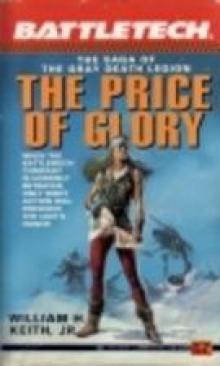 The Price of Glory
The Price of Glory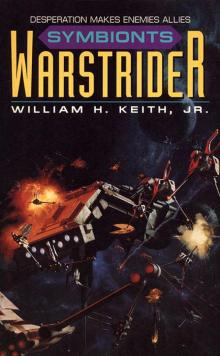 Symbionts
Symbionts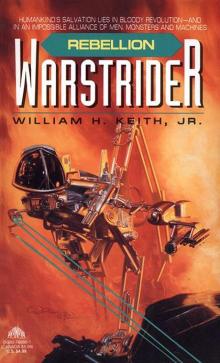 Rebellion
Rebellion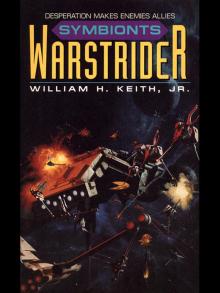 Warstrider 04 - Symbionts
Warstrider 04 - Symbionts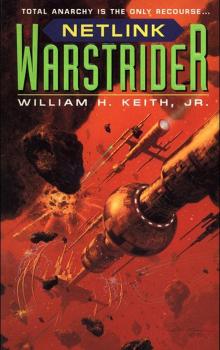 Netlink
Netlink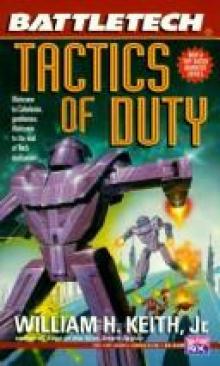 Tactics of Duty
Tactics of Duty Warstrider 06 - Battlemind
Warstrider 06 - Battlemind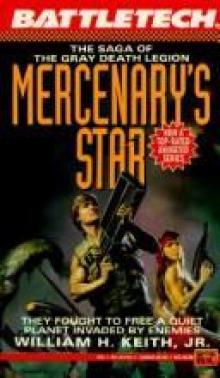 Mercenary's Star
Mercenary's Star Battlemind
Battlemind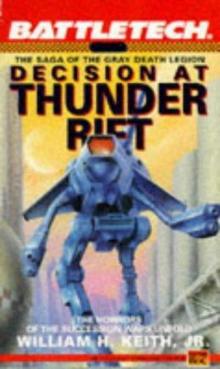 Decision at Thunder Rift
Decision at Thunder Rift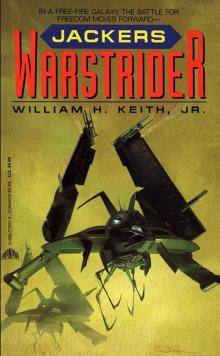 Jackers
Jackers Android: Free Fall
Android: Free Fall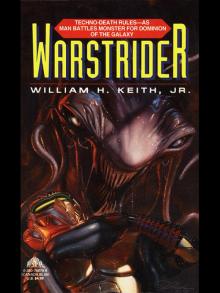 Warstrider 01 - Warstrider
Warstrider 01 - Warstrider Warstrider 05 - Netlink
Warstrider 05 - Netlink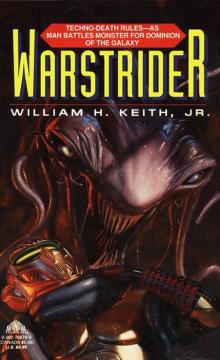 Warstrider
Warstrider